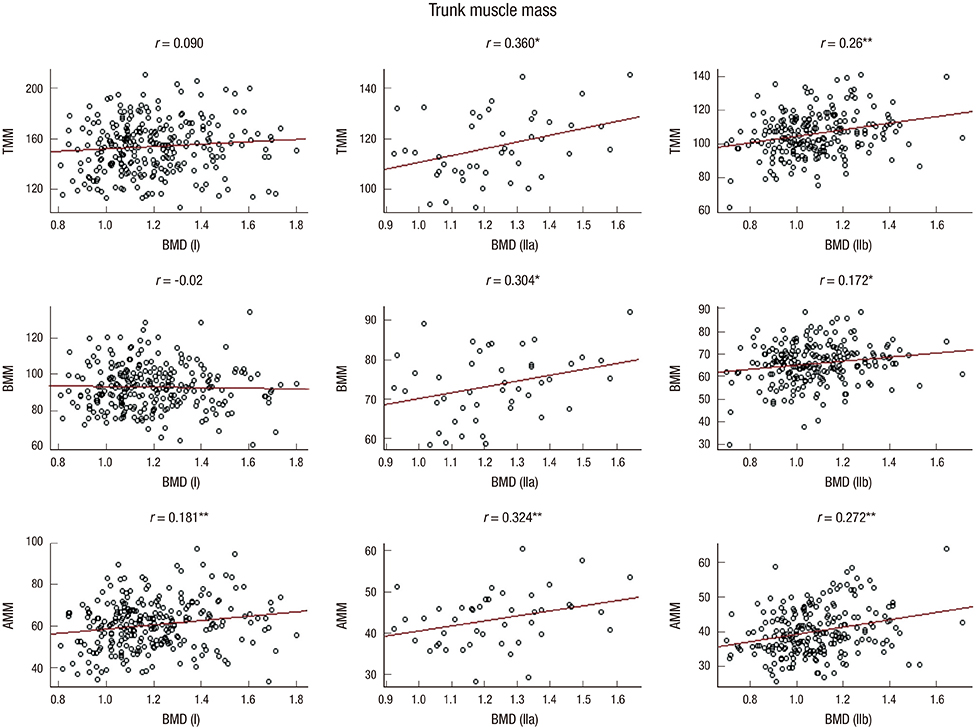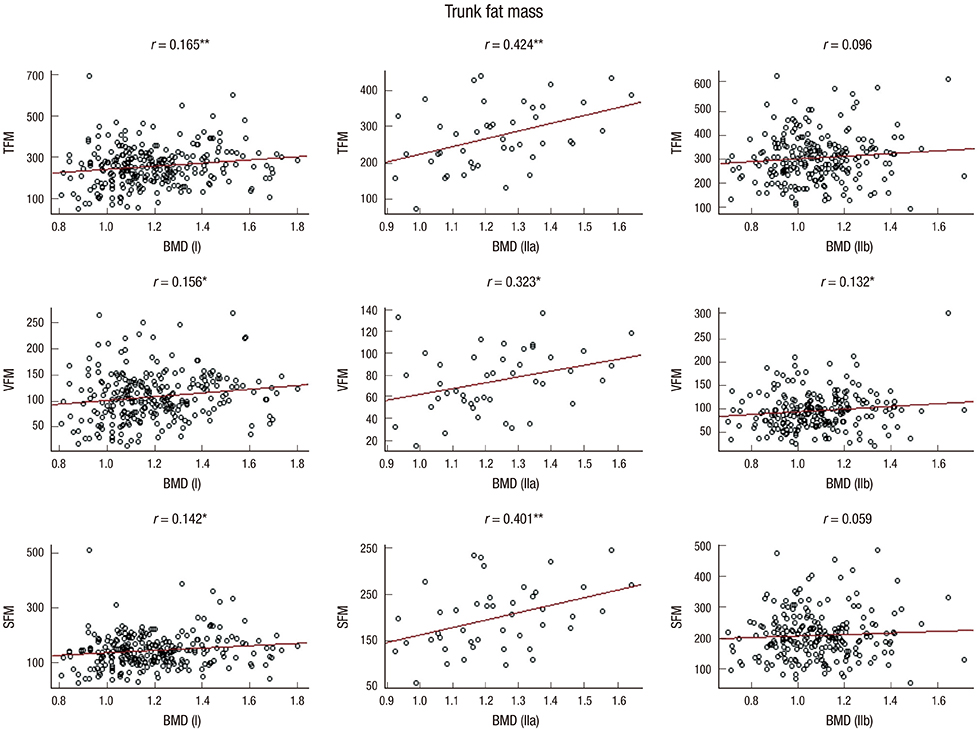J Korean Med Sci.
2016 Oct;31(10):1595-1603. 10.3346/jkms.2016.31.10.1595.
The Association between Trunk Body Composition and Spinal Bone Mineral Density in Korean Males versus Females: a Farmers' Cohort for Agricultural Work-Related Musculoskeletal Disorders (FARM) Study
- Affiliations
-
- 1Center for Farmers' Safety and Health and Department of Rehabilitation Medicine, Kangwon National University Hospital, Chuncheon, Korea. stewardofgod@gmail.com
- 2Department of Rehabilitation Medicine, School of Medicine, Kangwon National University, Chuncheon, Korea.
- 3Gangwon Do Rehabilitation Hospital, Chuncheon, Korea.
- 4Department of Rehabilitation Medicine, Seoul National University Bundang Hospital, Seongnam, Korea.
- KMID: 2468250
- DOI: http://doi.org/10.3346/jkms.2016.31.10.1595
Abstract
- The purpose of this study was proposed to identify the association of trunk body composition with spinal bone mineral density (BMD) in Korean male and female farmers. A total of 523 Korean farmers (259 males, 44 premenopausal females, and 220 postmenopausal females) were recruited. Computed tomography scans were acquired at the mid-L4 vertebral level, and total trunk muscle mass (TMM, cm3), back muscle mass (BMM), and abdominal wall muscle mass (AMM), total trunk fat mass (TFM), visceral fat mass (VFM), and subcutaneous fat mass (SFM) were assessed. Spinal BMD (g/cm2) was estimated from dual-energy X-ray absorptiometry at the L4 level. In terms of muscle mass, spinal BMD was significantly correlated with all the components of the trunk muscle mass (r = 0.171-0.360; P < 0.05, P < 0.001) in female farmers, while only with AMM (r = 0.181; P < 0.01) in male farmers. In terms of fat mass, spinal BMD was significantly correlated with all components of the trunk fat mass (r = 0.142-0.424; P < 0.05, P < 0.001) in male and premenopausal female farmers, while only with VFM (r = 0.132; P < 0.05) in postmenopausal females. Adjusted multivariate regression analysis showed that AMM in male and post-menopausal female farmers was closely associated with spinal BMD. There may be positive associations between trunk muscle and fat mass and spinal BMD with sexual dimorphism, and abdominal wall muscle mass was an explanatory variable closely related to spinal BMD in Korean farmers. Registered at the Clinical Research Information Service (CRIS, http://cris.nih.go.kr), number KCT0000829.
Keyword
MeSH Terms
-
Absorptiometry, Photon
Adult
Aged
Asian Continental Ancestry Group
Body Composition/*physiology
Body Mass Index
Bone Density/*physiology
Cohort Studies
Demography
Farmers
Female
Humans
Linear Models
Male
Middle Aged
Muscle, Skeletal/diagnostic imaging
Musculoskeletal Diseases/metabolism/*pathology
Republic of Korea
Sex Factors
Tomography, X-Ray Computed
Figure
Reference
-
1. Kim SM, Kim SH, Kim JJ, Kim MJ, Kwon HT, Suh CS, Choi YM, Kim JG. Increased bone mineral density according to increase of skeletal muscle mass in 534 Korean women: a retrospective cohort study conducted over 2.7 years. Obstet Gynecol Sci. 2015; 58:135–143.2. Chen Y, Xiang J, Wang Z, Xiao Y, Zhang D, Chen X, Li H, Liu M, Zhang Q. Associations of bone mineral density with lean mass, fat mass, and dietary patterns in postmenopausal Chinese women: a 2-year prospective study. PLoS One. 2015; 10:e0137097.3. Zhu K, Hunter M, James A, Lim EM, Walsh JP. Associations between body mass index, lean and fat body mass and bone mineral density in middle-aged Australians: The Busselton Healthy Ageing Study. Bone. 2015; 74:146–152.4. Baker JF, Davis M, Alexander R, Zemel BS, Mostoufi-Moab S, Shults J, Sulik M, Schiferl DJ, Leonard MB. Associations between body composition and bone density and structure in men and women across the adult age spectrum. Bone. 2013; 53:34–41.5. Cheng Q, Zhu YX, Zhang MX, Li LH, Du PY, Zhu MH. Age and sex effects on the association between body composition and bone mineral density in healthy Chinese men and women. Menopause. 2012; 19:448–455.6. Jo H, Baek S, Park HW, Lee SA, Moon J, Yang JE, Kim KS, Kim JY, Kang EK. Farmers' cohort for agricultural work-related musculoskeletal disorders (FARM) study: study design, methods, and baseline characteristics of enrolled subjects. J Epidemiol. 2016; 26:50–56.7. Gnudi S, Sitta E, Fiumi N. Relationship between body composition and bone mineral density in women with and without osteoporosis: relative contribution of lean and fat mass. J Bone Miner Metab. 2007; 25:326–332.8. Frost HM. Bone's mechanostat: a 2003 update. Anat Rec A Discov Mol Cell Evol Biol. 2003; 275:1081–1101.9. Panjabi MM. The stabilizing system of the spine. Part I. function, dysfunction, adaptation, and enhancement. J Spinal Disord. 1992; 5:383–389.10. Peptan IA, Hong L, Mao JJ. Comparison of osteogenic potentials of visceral and subcutaneous adipose-derived cells of rabbits. Plast Reconstr Surg. 2006; 117:1462–1470.11. Wardlaw GM. Putting body weight and osteoporosis into perspective. Am J Clin Nutr. 1996; 63:433S–6S.12. Izzo R, Guarnieri G, Guglielmi G, Muto M. Biomechanics of the spine. Part I: spinal stability. Eur J Radiol. 2013; 82:118–126.13. Mitsiopoulos N, Baumgartner RN, Heymsfield SB, Lyons W, Gallagher D, Ross R. Cadaver validation of skeletal muscle measurement by magnetic resonance imaging and computerized tomography. J Appl Physiol. 1985; 1998:115–122.14. Wells JC, Fewtrell MS. Measuring body composition. Arch Dis Child. 2006; 91:612–617.15. Nur H, Toraman NF, Arica Z, Sarier N, Samur A. The relationship between body composition and bone mineral density in postmenopausal Turkish women. Rheumatol Int. 2013; 33:607–612.16. Saarelainen J, Honkanen R, Kröger H, Tuppurainen M, Jurvelin JS, Niskanen L. Body fat distribution is associated with lumbar spine bone density independently of body weight in postmenopausal women. Maturitas. 2011; 69:86–90.17. Georgescu CE, Ilie I, Brad C, Duncea I. Association between body composition and bone mineral density in healthy, non-obese, young Romanian adults and effects of menopause. Maedica (Buchar). 2010; 5:24–27.18. Hicks GE, Simonsick EM, Harris TB, Newman AB, Weiner DK, Nevitt MA, Tylavsky FA. Cross-sectional associations between trunk muscle composition, back pain, and physical function in the health, aging and body composition study. J Gerontol A Biol Sci Med Sci. 2005; 60:882–887.19. Li S, Wagner R, Holm K, Lehotsky J, Zinaman MJ. Relationship between soft tissue body composition and bone mass in perimenopausal women. Maturitas. 2004; 47:99–105.20. Lim S, Joung H, Shin CS, Lee HK, Kim KS, Shin EK, Kim HY, Lim MK, Cho SI. Body composition changes with age have gender-specific impacts on bone mineral density. Bone. 2004; 35:792–798.21. Gjesdal CG, Halse JI, Eide GE, Brun JG, Tell GS. Impact of lean mass and fat mass on bone mineral density: The Hordaland Health Study. Maturitas. 2008; 59:191–200.22. Kirchengast S, Huber J. Sex-specific associations between soft tissue body composition and bone mineral density among older adults. Ann Hum Biol. 2012; 39:206–213.23. Kuk JL, Katzmarzyk PT, Nichaman MZ, Church TS, Blair SN, Ross R. Visceral fat is an independent predictor of all-cause mortality in men. Obesity (Silver Spring). 2006; 14:336–341.24. Smidt GL, Lin SY, O'Dwyer KD, Blanpied PR. The effect of high-intensity trunk exercise on bone mineral density of postmenopausal women. Spine. 1992; 17:280–285.25. Sinaki M, Itoi E, Wahner HW, Wollan P, Gelzcer R, Mullan BP, Collins DA, Hodgson SF. Stronger back muscles reduce the incidence of vertebral fractures: a prospective 10 year follow-up of postmenopausal women. Bone. 2002; 30:836–841.26. Fu X, Ma X, Lu H, He W, Wang Z, Zhu S. Associations of fat mass and fat distribution with bone mineral density in pre- and postmenopausal Chinese women. Osteoporos Int. 2011; 22:113–119.27. Blaauw R, Albertse EC, Hough S. Body fat distribution as a risk factor for osteoporosis. S Afr Med J. 1996; 86:1081–1084.28. Zhang H, Chai X, Li S, Zhang Z, Yuan L, Xie H, Zhou H, Wu X, Sheng Z, Liao E. Age-related changes in body composition and their relationship with bone mineral density decreasing rates in central south Chinese postmenopausal women. Endocrine. 2013; 43:643–650.29. Kiebzak GM, Leamy LJ, Pierson LM, Nord RH, Zhang ZY. Measurement precision of body composition variables using the lunar DPX-L densitometer. J Clin Densitom. 2000; 3:35–41.30. Bredella MA, Ghomi RH, Thomas BJ, Torriani M, Brick DJ, Gerweck AV, Misra M, Klibanski A, Miller KK. Comparison of DXA and CT in the assessment of body composition in premenopausal women with obesity and anorexia nervosa. Obesity (Silver Spring). 2010; 18:2227–2233.31. Hu ZJ, He J, Zhao FD, Fang XQ, Zhou LN, Fan SW. An assessment of the intra- and inter-reliability of the lumbar paraspinal muscle parameters using CT scan and magnetic resonance imaging. Spine. 2011; 36:E868–74.32. Blain H, Vuillemin A, Teissier A, Hanesse B, Guillemin F, Jeandel C. Influence of muscle strength and body weight and composition on regional bone mineral density in healthy women aged 60 years and over. Gerontology. 2001; 47:207–212.33. Huuskonen J, Väisänen SB, Kröger H, Jurvelin C, Bouchard C, Alhava E, Rauramaa R. Determinants of bone mineral density in middle aged men: a population-based study. Osteoporos Int. 2000; 11:702–708.34. Sinaki M, McPhee MC, Hodgson SF, Merritt JM, Offord KP. Relationship between bone mineral density of spine and strength of back extensors in healthy postmenopausal women. Mayo Clin Proc. 1986; 61:116–122.
- Full Text Links
- Actions
-
Cited
- CITED
-
- Close
- Share
- Similar articles
-
- Work-related musculoskeletal disorders in Korean farmers
- Factors Affecting Musculoskeletal Symptoms among Korean Farmers: Focusing on the Sociodemographic Characteristics
- Work-related diseases of agricultural workers in South Korea
- Clinical Usefulness of X-Ray Findings for Non-specific Low Back Pain in Korean Farmers: FARM Study
- A Cross-sectional Study of Musculoskeletal Symptoms and Risk Factors in Cambodian Fruit Farm Workers in Eastern Region, Thailand




